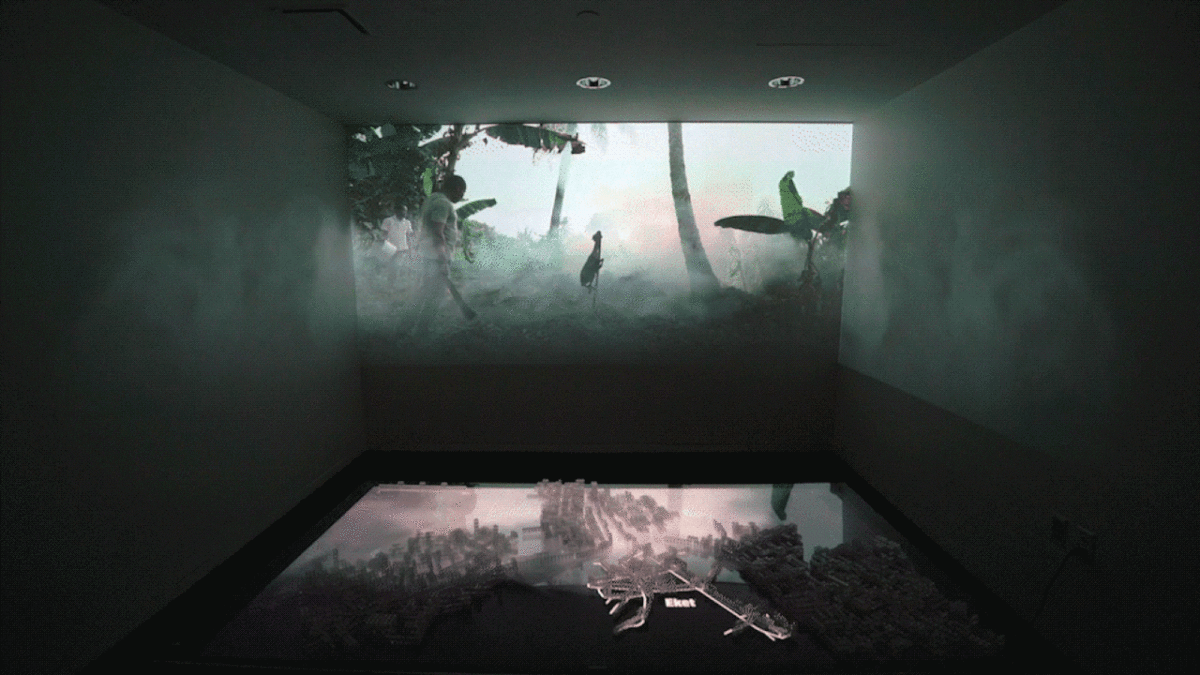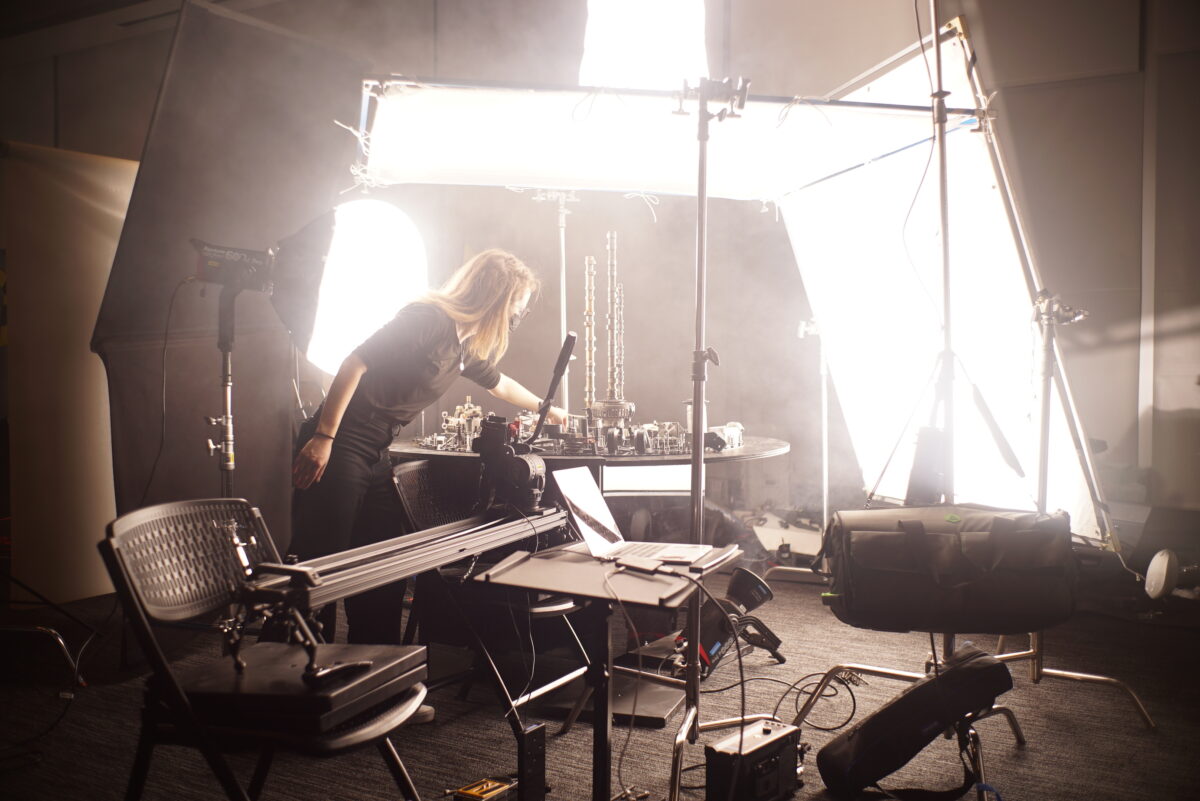Two installations at the Venice Architecture Biennale and the Guggenheim Bilbao invite visitors to explore the future of urban mobility
How can we research the future? It’s a question that Gabriela Bílá Advincula (MS ’21) asks herself daily in her work as a researcher in the City Science group at the MIT Media Lab. As an architect, multimedia designer, and artist, Bílá’s answers often take the form of visually rich and technologically complex installations—exercises in world building that empower visitors to become active participants in the future of their cities.
Funded by a Grant from the Council for the Arts at MIT (CAMIT), Bílá collaborated with the team at City Science and others to expand her MIT Media Lab Master’s thesis, entitled With(in), into an immersive installation for the 2021 Venice Architecture Biennale. A new installation, Two Mobility Futures 0∞, developed by Bílá, City Science, and collaborators, with an International Exhibitions Grant from MIT Center for Art, Science & Technology (CAST), now forms part of the Guggenheim Bilbao’s exhibition Motion. Autos, Art, Architecture, curated by Lord Norman Foster.
Experiential Storytelling
Both projects share a defining commitment to human-centered storytelling, recognizing that the intimate details of daily life provide vital touchpoints for understanding interconnected systems and rapid urbanization. With(in) tells the story of three women living in informal settlements within larger cities: MamaG in Port Harcourt, Nigeria, Eva in Guadalajara, Mexico, and Gihan in Cairo, Egypt. Constructed as a series of digital screens and volumetric city models, With(in) reveals the resourceful ways that these three women navigate their environments, focusing on rituals of food preparation as the nexus of community life.
Two Mobility Futures 0∞ proposes two extremes of mobility, “zero” to “infinite”: zero mobility imagines a future where all resources are delivered to each household, whereas infinite mobility would be a state of frictionless global movement. Applying a comparable format of immersive screens and a centralized model (in this case, a fantastical city constructed from parts of a car engine), the installation explores these divergent futures through three evocative narratives: “Windows,” “Luggage,” and “Love.”
“Storytelling is central to my practice,” explains Bílá. “I was among the first generation to grow up in Brasília, immersed in the logic and mythology of a modernist utopia. That gave me a fascination with the way cities project possible futures, and how urban design can facilitate encounters and strengthen communities. At the same time, one was always implicitly aware of the hand of the master planner, the invisible forces directing any chosen path through the city. That made me highly sensitive to the potential disconnection between design and human lived experience—storytelling became a way to bring back that intimacy, to bridge that divide.”

Collaborative World Building
Those experiments in storytelling first took the form of interactive exhibitions for science communication—most prominently, Bílá’s traveling exhibition, Teleport City, which speculated on the impact of rapid changes in mass transportation. “When I embarked on my Master’s degree at the MIT Media Lab, my goal was to strengthen my technological toolkit, experimenting with artistic methodologies as a way to broadcast architectural discussion,” says Bílá. “However, I hadn’t realized how much my experience in the lab and the classroom would deepen my engagement with the human aspect of design. That’s something that Kent Larson, the director of the Media Lab’s City Science research group, has placed at the center of our approach to data-collecting, concept development, and practical application.”
As Bílá sees it, her most powerful resources are the people that surround her. “That’s what’s so special about being part of MIT,” she says. “You have access to experts in an incredible range of disciplines—by drawing on that knowledge base, we have the chance to significantly expand what is possible to imagine and realize for our urban futures.” The design of With(in) and Two Mobility Futures 0∞ involved collaborating with the City Science team to tell stories that could be experienced at multiple levels, whether through cinematography, model construction, or sound design. The filming of the three narratives for Two Mobility Futures 0∞ proved particularly complex, involving building an entire film set suited to live action scenes and close-up filming inside the city model itself. Cinematographer and visual artist Sean Webley refined a series of highly specialized filming techniques to create the appearance of a dynamic urban setting—from using a macro probe lens to amplify the sense of scale, to immersing sections of the model under water to simulate fluctuating weather conditions.

Redefining Research
When developing the installations, Bílá views the research process as threefold. At one level, there is the ethnographic approach to gathering data and stories; in the case of With(in), Bílá spent time as a guest of each of the three women, immersed in their daily activities and becoming an inextricable part of the processes later projected on screen; from the act of baking bread, to sacramental rituals before a funeral. The next stage of research involves testing in the lab, exploring the forms that an interactive platform might take, and advancing the concept through iterative experimentation. Observation of visitors’ responses to an installation also serves as an important source of information, allowing for on-site adjustments and new insights to optimize audience engagement.
“The sights and sounds that captivate us actively shape our understanding of the world, defining what we value and how we act” says Bílá. “By identifying and analyzing what attracts an audience’s attention, we’re able to strategize how to bring debates about urban design to a broader public. That inclusive participation is especially important now, when we find ourselves at a critical juncture: there’s a glamor to the idea of the smart city and autonomous systems, but my hope is that we can focus our efforts towards developing an infrastructure for shared mobility, where freedom of movement is a public right.”
Ultimately, the future of our cities depends on the collective capacity to pay close attention to human lived experience. The two installations create the conditions for relating to our surroundings with compassion and curiosity; they serve as microcosms of ideal cities, spaces where the future of mobility is all about facilitating new encounters.
Article by Matilda Bathurst, Arts at MIT
Editorial Direction by Leah Talatinian, Arts at MIT
MIT City Science Collaborators:
Principal Investigator: Kent Larson
Project Director: Gabriela Bila Advincula
Project Manager: Maitane Iruretagoyena
Creative Technology Director: Thomas Sanchez Langeling
City Science Coordinator: Margaret Church
Media Artist: Justin Blinder
Storytellers: Luis Alonso Pastor, Naroa Coretti, Yasushi Sakai
Soundtrack: Holger Prang, Xiao Xiao
External Collaborators:
Director of Photography: Sean Webley
Video Editors: Lucas Seixas, Pedro Ribeiro
Performers: Jenna Riegel, Joel Panepinto, Pallas Yao, Shaneeka Harrell
Script Advisor: Ana Carneiro
Set Design Assistants: Alyssa Jewell, Josiah Mayo
Set Assistants: Felix Li, Ishita Bhimavarapu
| Special thanks to: Carson Smuts, Jason Nawyn, Markus Elkatsha, Joshua Higgason, Sarah L. Brown, Samantha Arango |
